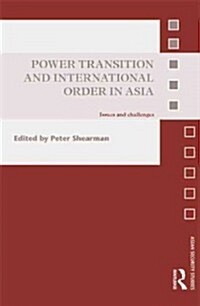This edited volume examines how the transition and diffusion of power in global politics is impacting on stability and order in East and Southeast Asia. Both in the academic field of International Relations (IR) and among policymakers, the big question today concerns the rise of China, the relative decline of the United States, and the increasing importance of East Asia in global politics. There are differences concerning the most likely impact the international power transition will have in the region, but observers agree that due to the changing relative distribution of power, economic forces in Asia, the increasing importance of energy security, and the myriad unresolved issues in the region -- including nuclear weapons proliferation and the standoff between India and Pakistan, Taiwan, the Korean issue, terrorists and insurgents in many parts of the region -- makes East and Southeast Asia a potential tinderbox for crises and conflict and even perhaps with a risk of Great Power war. This volume brings together leading scholars from around the world to assess current thinking in IR on these issues, and also to apply appropriate theories and methods of analysis in their specific area of expertise to help us understand better the likely impact that the changing global power distribution will have in East and Southeast Asia. In addition to a changing distribution of power among the leading states in the international system, there is also said to be an ongoing diffusion of power away from states to non-state actors. Hence, in addition to examining changing relations between the Great Powers in the region the book will also assess the impact that other actors, from terrorist groups, insurgents and organized crime syndicates could have on stability and order. With the changing balance of power in the region the main state actors likely to play the most important roles are China, India, Japan, and Russia. Hence specialists on each of these countries provide an analysis on current thinking in IR about their role in the region and offer their own analysis and interpretation about likely future directions these countries will take, again focusing on questions of order and stability. The two powers outside of the region itself that are most often thought as major forces with strong interests in Asia are the United States and, perhaps more controversially, the EU, and these too are covered together in a separate chapter. In addition, there is an evaluation of the institutions that could have a bearing on international order in the region, with separate chapters on the Shanghai Cooperation Organization and the Association of Southeast Asian Nations.This book will be of much interest to students of Asian politics, security studies, diplomacy and international relations.

